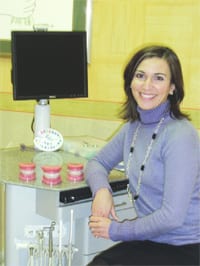A Profession to Sink Her Teeth Into Yanni Has Built Her Practice Through Word-of-mouth Referrals
Janice Yanni’s story of how and why she became an orthodontist revolves around jewelry.
Although her two older siblings are both dentists and she spent a lot of time as a child visiting them when they were in dental school, the owner of Yanni Orthodontics in West Springfield and Tolland, Conn. has never forgotten the day she decided to make dentistry her life career.
The inspiration came during one of those visits. “They told me that gold jewelry was made using the same process that is used to make crowns for teeth, and I thought that was the coolest thing,” she said, adding that templates are used to make jewelry in dental school. “From that moment on, it became my career path.”
The decision was cemented when she worked in her brother’s dental office during high school and learned to appreciate the rewards the profession offered. She wanted to go into a medical field, but couldn’t see herself working in an emergency room or being constantly on call.
She has excelled in her profession and loves what she does. In 2007 the Mass. Dental Society named her as one of its ‘Ten Under 10’ dentists. The award is presented to those who have graduated from dental school within 10 years and made significant contributions to the profession, their community, and to dentistry.
In 2008 and 2010, Yanni also made Hartford magazine’s list of top dentists.
The mother of two children, ages 2 and 1, Yanni has a small basketball court in her West Springfield office. There are days when kids can get rowdy there as a result, but catering to her patients’ needs, making them comfortable, and establishing long-term relationships with them are integral to her practice.
Yanni’s patients come to see her at as early as age 7, and their care often continues throughout their high school years. “What I liked most in my residency was that I got to see children as they grew,” she said. “I may see a child at a young age, and whether they need something or not, I follow them every six months. The average age braces are put on is between 12 and 15 and then I follow those patients for two years after their treatment is finished. So I can potentially see children from age 7 to 18 and watch them change from little girls and boys into college students.”
About 25{06cf2b9696b159f874511d23dbc893eb1ac83014175ed30550cfff22781411e5} of her patients are adults who seek help to create a beautiful smile or explore their options after losing a tooth or having other problems that affect their bite or cause their teeth to shift. She is happy to help everyone she can, and says significant advances in dentistry and orthodontics have made it possible for adults to get their teeth in perfect alignment and have a beautiful smile without having to suffer the pain or appearance associated with metal braces that were their only option a decade ago.
For this special section on dental services, Yanni talked a little about her practice, but mostly about advances in her field and what they mean for her patients.
Cutting-edge Treatment
Yanni said invisible braces were introduced to the public in 1999. Several companies make them today, with the most prominent being Invisalign. They change the position of teeth via a series of clear, removable aligners that are custom made to fit an individual’s mouth. They are changed every two weeks, and have to be removed to eat, but other than that, are worn 24 hours a day.
“They move the teeth little by little, one tray at a time. It is a great product, but it is not appropriate for everyone. It has some limitations based on the way a person’s teeth fit together,” said Yanni, adding that if a person needs extractions, invisible braces may not work, because the trays only allow for limited movement of teeth.
However, people who only need minor adjustments are often happy with Invisialign’s Express system, which is designed to have the same outcome as traditional braces in a shorter period of time.
“Invisible braces give adults or teenagers a very nice aesthetic choice,” Yanni explained. They cost about $1,500 more than traditional, fixed ones, and although their use is not limited to adults, most parents opt for traditional ceramic or metal braces for their children.
“Kids have enough to think about, including their sports and activities and it would be very easy for the invisible braces to end up being thrown out on a cafeteria tray,” said Glen Nicholes, office manager for Yanni Orthodontics.
Patients who seek a different cutting-edge option can find it in Yanni’s offices as she says her business is the premier area provider of Incognito braces. “People have traveled 4 1/2 hours to get here because they want these braces,” she said.
Incognito braces are attached to the rear surface of the teeth rather than the front, so they cannot be seen. They cost about $2,500 more than traditional fixed braces, are made by a German company, and debuted in the U.S. in 2005. The system uses cast gold customized brackets for each tooth, and custom-made braces cast in Germany using a precision machine.
“They are fixed braces, and almost everyone is a candidate for them. It’s a good option for people who want to straighten their teeth with braces that are 100 {06cf2b9696b159f874511d23dbc893eb1ac83014175ed30550cfff22781411e5} hidden and don’t fall into the realm of those who can use invisible braces or who don’t want an appliance they have to take out when they eat,” Yanni said.
The Incognito system also provides a more ideal outcome than invisible braces because they allow the orthodontist to maintain total control throughout the course of a person’s treatment as it allows him/her to make adjustments to the actual physical hardware. However, invisible braces do work well if the candidate is diagnosed and treated appropriately, Yanni said, adding the majority of adults do want braces that cannot be seen.
Another revolutionary advance in dentistry is the use of TADs or temporary anchorage devices, which are implanted into the jawbone for several months. “They allow teeth to be moved in a fashion that was never possible before as they provide ultimate anchorage,” Yanni said.
She explained that wires (springs or elastics may also be used) are attached to teeth that need to be moved. Larger teeth have strong, multifaceted roots and can be used as anchors. But in many cases, the orthodontist may not want the anchored tooth to move at all and since any tooth will move in response to a force, implanting a TAD for a short period of time can prevent this.
TADs resemble wood screws because they are threaded and about half the length of a thumbnail. But they are usually no wider than the width of the head of a pin and can be made from stainless steel or titanium. In the past, they were expensive and difficult to place, but advances in the field have made them safer and less expensive.
TADs can be used for a number of situations, which include providing an anchorage point where tooth anchorage is not normally available; allowing limited tooth movement in preparation for a bridge, crown, or implant without braces; and closing bites without the use of surgery. They can also shorten the time braces need to be on when they are used in conjuntion with them. TADs do not work for every patient but in many cases, they can shorten treatment and improve the final outcome.
“They have changed orthodonistry,” said Yanni. “TADs and Incognito give us the ability to cater to more patients and to people who would never have considered regular braces.”
As these innovations have evolved, orthodontic treatment has also become more comfortable for patients. “The days of cranking braces are gone. Today there is a light, continuous force that is used throughout the course of treatment to make braces more comfortable,” she said.
When Yanni moved to Western Mass. from Ohio after completing her education, she accepted a position in another practice. But it wasn’t long before she made the decision to open her own business. “I wanted to instill my own vision and treat patients the way I would want to be treated and the way I would want my children to be treated,” she said.
Crowning Achievements
Yanni said she is dedicated to spending time with each patient and making sure they get the best individualized care she can provide.
“I don’t want anyone to be a number. I want to form relationships; let it be a journey that not only provides lasting impressions clinically, but one in which they think of me as a friend,” she told the Healthcare News.
The relationship is one that leaves her patients with a lasting gift far better than the gold jewelry that sparked her interest years ago — a bright and gleaming smile.



Comments are closed.